Drought tolerant maize wins UK climate prize
The United Kingdom’s Department for International Development (DFID) has won Best Technological Breakthrough at the 2012 UK Climate Week Awards for its support to the Drought Tolerant Maize for Africa (DTMA) project. The awards were held in London on 12 March 2012 to celebrate the UK’s most effective and ambitious organizations, communities, and individuals and their efforts to combat climate change.
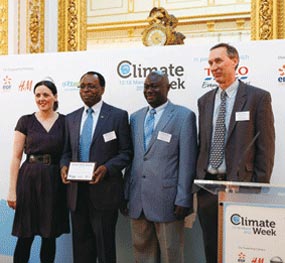 DTMA has been responsible for the development and dissemination of 34 new drought-tolerant maize varieties to farmers in 13 project countries—Angola, Benin, Ethiopia, Ghana, Kenya, Malawi, Mali, Mozambique, Nigeria, Tanzania, Uganda, Zambia, and Zimbabwe—between 2007 and 2011. An estimated two million smallholder farmers are already using the drought-tolerant maize varieties and have obtained higher yields, improved food security, and increased incomes.
DTMA has been responsible for the development and dissemination of 34 new drought-tolerant maize varieties to farmers in 13 project countries—Angola, Benin, Ethiopia, Ghana, Kenya, Malawi, Mali, Mozambique, Nigeria, Tanzania, Uganda, Zambia, and Zimbabwe—between 2007 and 2011. An estimated two million smallholder farmers are already using the drought-tolerant maize varieties and have obtained higher yields, improved food security, and increased incomes.
Drought-tolerant varieties are invaluable on a continent where maize is the staple crop for over 300 million people, and nearly always relies on rainwater alone. The DTMA varieties, produced by conventional breeding, provide farmers with better yields than leading commercial varieties under moderate drought conditions, while also giving outstanding harvests when rains are good. DTMA works with a diverse network of partners to develop, market, and distribute seed, including private companies, publicly funded agricultural research and extension systems, ministries of agriculture, nongovernmental organizations, and community-based seed producers.
Jointly implemented by CIMMYT and the International Institute for Tropical Agriculture (IITA), the DTMA project is presently funded by the Bill & Melinda Gates Foundation (BMGF) and is also receiving complementary grants from the Howard G. Buffett Foundation (HGBF) and the United States Agency for International Development (USAID).
“DFID has been a highly-valued and reliable, top-ten core contributor to CIMMYT’s work,” said DTMA project leader Wilfred Mwangi. In addition, the efforts of DTMA build on long-term support from the Swiss Agency for Development Cooperation (SDC), the German Federal Ministry for Economic Cooperation and Development (BMZ), the International Fund for Agricultural Development (IFAD), the Rockefeller Foundation, USAID, the United Nations Development Program (UNDP), and the Eiselen-Foundation.
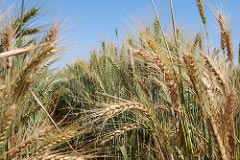 [MEXICO CITY] Mexican researchers have welcomed a breakthrough in imaging plant roots, saying it could help breeders develop new varieties of
[MEXICO CITY] Mexican researchers have welcomed a breakthrough in imaging plant roots, saying it could help breeders develop new varieties of  Meeting was held in the Indian holy city of Varanasi during 27 February to 01 March 2012. It was organized jointly by Banaras Hindu University (BHU), HarvestPlus, and CIMMYT to discuss wheat biofortification research outputs and future plans. The meeting was attended by about 40 scientists, including Hans Braun, Ravi Singh, Kevin Pixley, Velu Govindan, Etienne Duveiller, Arun Joshi, and Iván Ortiz-Monasterio from CIMMYT, along with participants from the Bill & Melinda Gates Foundation, HarvestPlus, the Indian national agricultural research system, the private sector, and more than 200 farmers from the eastern part of the state of Uttar Pradesh.
Meeting was held in the Indian holy city of Varanasi during 27 February to 01 March 2012. It was organized jointly by Banaras Hindu University (BHU), HarvestPlus, and CIMMYT to discuss wheat biofortification research outputs and future plans. The meeting was attended by about 40 scientists, including Hans Braun, Ravi Singh, Kevin Pixley, Velu Govindan, Etienne Duveiller, Arun Joshi, and Iván Ortiz-Monasterio from CIMMYT, along with participants from the Bill & Melinda Gates Foundation, HarvestPlus, the Indian national agricultural research system, the private sector, and more than 200 farmers from the eastern part of the state of Uttar Pradesh. In 2001, CIMMYT published
In 2001, CIMMYT published 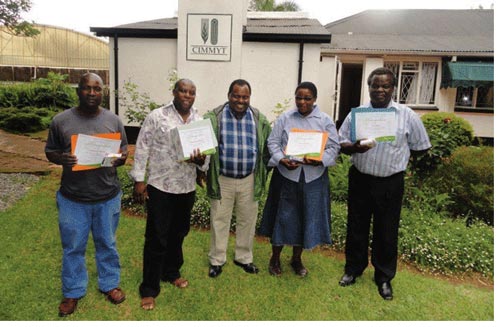 2012 is already proving to be big and eventful year for CIMMYT’s Southern Africa Regional Office, with half a dozen CIMMYT-Zimbabwe staff receiving honours for years of dedicated service to the organisation. At a luncheon event held on 02 March 2012 at the CIMMYT-Zimbabwe offices, Sebastian Mawere and John Chifamba each received awards for 25 years of service. The office also celebrated 20 years of dedicated service by Esau Tofa, 15 years by Nothando Moyo and Taksure Ndlovu, and 10 by Simbarashe Chisoro.
2012 is already proving to be big and eventful year for CIMMYT’s Southern Africa Regional Office, with half a dozen CIMMYT-Zimbabwe staff receiving honours for years of dedicated service to the organisation. At a luncheon event held on 02 March 2012 at the CIMMYT-Zimbabwe offices, Sebastian Mawere and John Chifamba each received awards for 25 years of service. The office also celebrated 20 years of dedicated service by Esau Tofa, 15 years by Nothando Moyo and Taksure Ndlovu, and 10 by Simbarashe Chisoro.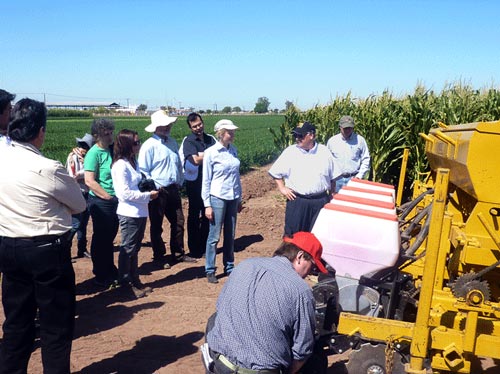 On 22 February 2012 we welcomed Howard G. Buffett and members of Sonora’s ‘Patronato’ (Patronato para la Investigación y Experimentación Agrícola del Estado de Sonora; PIEAES) to CIMMYT’s CENEB (Campo Experimental Norman E. Borlaug) station near Ciudad Obregón, Sonora, Mexico. The visit emphasized our joint concerns to improve food security and identified shared interests for improving opportunities for smallholder farmers and local entrepreneurs, and for widespread promotion of CA.
On 22 February 2012 we welcomed Howard G. Buffett and members of Sonora’s ‘Patronato’ (Patronato para la Investigación y Experimentación Agrícola del Estado de Sonora; PIEAES) to CIMMYT’s CENEB (Campo Experimental Norman E. Borlaug) station near Ciudad Obregón, Sonora, Mexico. The visit emphasized our joint concerns to improve food security and identified shared interests for improving opportunities for smallholder farmers and local entrepreneurs, and for widespread promotion of CA.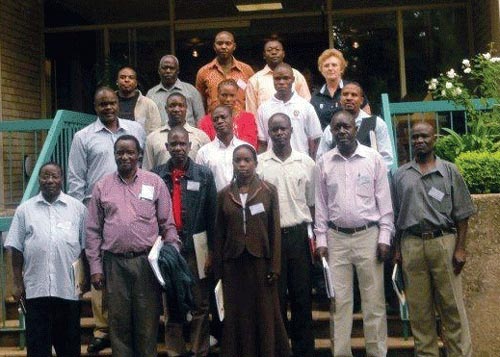
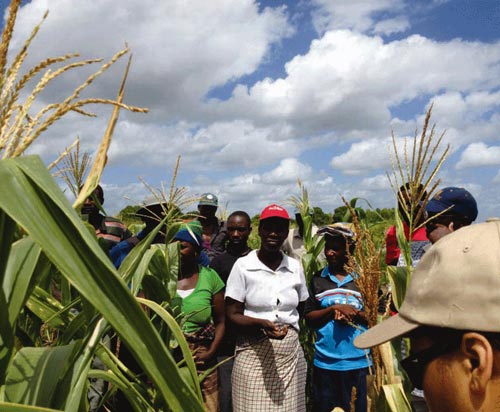 “Increasing Sustainable Agricultural Production in Mozambique through Drought Tolerant Maize and Conservation Agriculture” is a USAID-supported initiative bringing together two key components of CIMMYT’s work: Breeding for drought tolerance and sustainable land management to mitigate the effects of climate change.
“Increasing Sustainable Agricultural Production in Mozambique through Drought Tolerant Maize and Conservation Agriculture” is a USAID-supported initiative bringing together two key components of CIMMYT’s work: Breeding for drought tolerance and sustainable land management to mitigate the effects of climate change.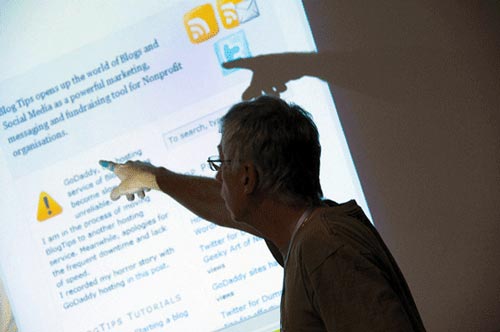 As part of the
As part of the 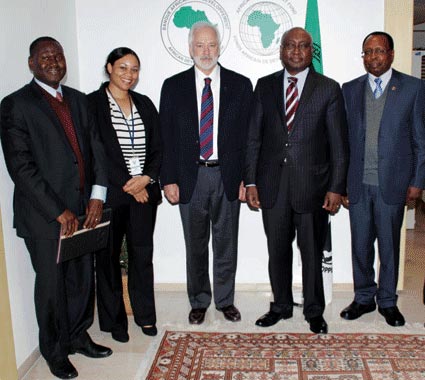 The group also discussed the MAIZE CRP and CIMMYT’s strong partnership with the International Institute of Tropical Agriculture (IITA). Institutional linkages such as these can be very beneficial to African smallholder farmers, as demonstrated by the major projects accomplished by CIMMYT’s Africa offices, such as Drought Tolerant Maize for Africa (DTMA), Sustainable Intensification of Maize- Legume Cropping Systems for Food Security in Eastern and Southern Africa (SIMLESA), Water Efficient Maize for Africa (WEMA), Insect Resistant Maize for Africa (IRMA), and Improved Maize for African Soils (IMAS). “CIMMYT has had an enormous impact on wheat in Africa. Most cultivars are CIMMYT derived and many wheat scientists from African NARS have been trained at CIMMYT,” said Ammar.
The group also discussed the MAIZE CRP and CIMMYT’s strong partnership with the International Institute of Tropical Agriculture (IITA). Institutional linkages such as these can be very beneficial to African smallholder farmers, as demonstrated by the major projects accomplished by CIMMYT’s Africa offices, such as Drought Tolerant Maize for Africa (DTMA), Sustainable Intensification of Maize- Legume Cropping Systems for Food Security in Eastern and Southern Africa (SIMLESA), Water Efficient Maize for Africa (WEMA), Insect Resistant Maize for Africa (IRMA), and Improved Maize for African Soils (IMAS). “CIMMYT has had an enormous impact on wheat in Africa. Most cultivars are CIMMYT derived and many wheat scientists from African NARS have been trained at CIMMYT,” said Ammar.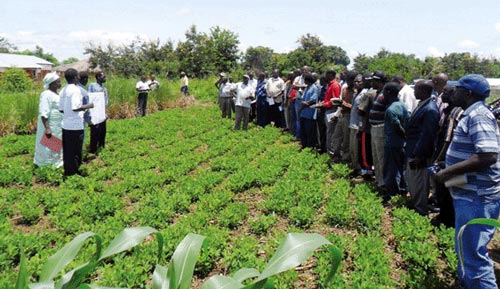 Since 2005, farmers, extension officers, and researchers have joined forces in starting a revolution from traditional farming systems in Malawi to locally adapted CA systems. The number of farmers practicing CA in the TLC communities of Central Malawi has grown from the initial 12 in 2005 to over 30,000 in 2012. This extension of CA was largely due to the development of an innovation network with different actors: Researchers assured training and quality implementation of the new technologies in target communities; the network facilitated participatory interaction and dialogue with farmers; and farmers raised social capital, subsequently boosting interest in the project within their own communities and the surrounding areas. These successful results enabled TLC and other partners to attract further funding and they linked farmers with input suppliers and a soft loan program for herbicides and improved seed. Farmers can currently access the input loan at seeding and pay back the amount for both inputs at harvest. Linking farmers to input markets was a major success, but more work needs to be done to also develop output markets for increased production from CA fields.
Since 2005, farmers, extension officers, and researchers have joined forces in starting a revolution from traditional farming systems in Malawi to locally adapted CA systems. The number of farmers practicing CA in the TLC communities of Central Malawi has grown from the initial 12 in 2005 to over 30,000 in 2012. This extension of CA was largely due to the development of an innovation network with different actors: Researchers assured training and quality implementation of the new technologies in target communities; the network facilitated participatory interaction and dialogue with farmers; and farmers raised social capital, subsequently boosting interest in the project within their own communities and the surrounding areas. These successful results enabled TLC and other partners to attract further funding and they linked farmers with input suppliers and a soft loan program for herbicides and improved seed. Farmers can currently access the input loan at seeding and pay back the amount for both inputs at harvest. Linking farmers to input markets was a major success, but more work needs to be done to also develop output markets for increased production from CA fields.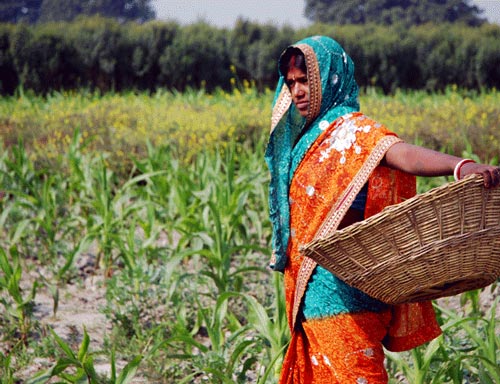 During 21 January-05 February, a delegation consisting of Director General Thomas Lumpkin, Global Wheat Program Associate Director and Head of Pathology, Etienne Duveiller, Board member Andy Barr, and Development Officer Cheraé Robinson travelled from El Batán to visit the three sites of the newly established Borlaug Institute for South Asia (BISA). They were accompanied by Ajai Kumar and Raj Gupta, from CIMMYT’s New Delhi office.
During 21 January-05 February, a delegation consisting of Director General Thomas Lumpkin, Global Wheat Program Associate Director and Head of Pathology, Etienne Duveiller, Board member Andy Barr, and Development Officer Cheraé Robinson travelled from El Batán to visit the three sites of the newly established Borlaug Institute for South Asia (BISA). They were accompanied by Ajai Kumar and Raj Gupta, from CIMMYT’s New Delhi office.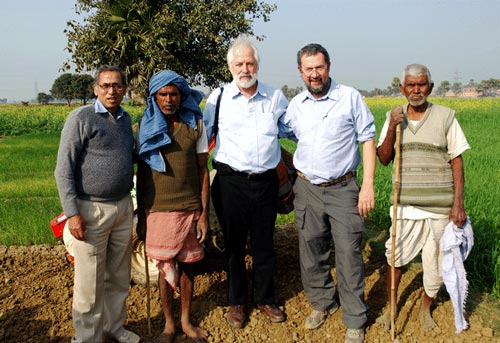
 On 08 February 2012, CIMMYT’s Director General Thomas Lumpkin participated as a speaker in the Economist Conference “Feeding the World: The 9 Billion People Question” in Geneva, Switzerland. Attendees included a number of high level representatives and government officials, including Kanayo Nwanze, President of the International Fund for Agricultural Development (IFAD), Jikun Huang, Founder and Director of the Center for Agricultural Policy, Chinese Academy of Sciences (CAAS), and Bruno Le Maire, the French Minister of Agriculture, Food, and Fishing.
On 08 February 2012, CIMMYT’s Director General Thomas Lumpkin participated as a speaker in the Economist Conference “Feeding the World: The 9 Billion People Question” in Geneva, Switzerland. Attendees included a number of high level representatives and government officials, including Kanayo Nwanze, President of the International Fund for Agricultural Development (IFAD), Jikun Huang, Founder and Director of the Center for Agricultural Policy, Chinese Academy of Sciences (CAAS), and Bruno Le Maire, the French Minister of Agriculture, Food, and Fishing.